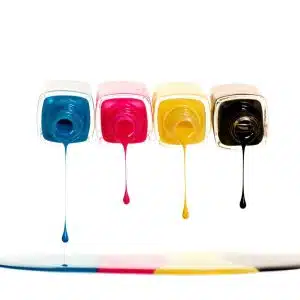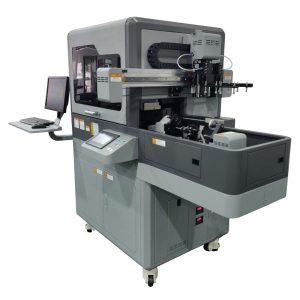Inkjet and pad printing on plastic
Printing on plastic can be done in a variety of ways. These include pad printing, screen printing, and inkjet printing. To make it possible, these printing processes utilize specialized ink for plastics. In this article, we will discuss what is needed for inkjet and pad printing on plastic.
Thermoplastics and thermosetting plastics
Two major categories of plastics are thermoplastics and thermosetting plastics (thermosets).
- Thermoplastics: These materials retain their plasticity after molding and can be reshaped.
- Thermosets: become insoluble after heating and/or mixing with hardener.
All plastic types fall into these two categories. Types of plastics included in the order of production volume are polyethylene (PE), polypropylene (PP), polyvinyl chloride (PVC), polystyrene (PS), polyethylene terephthalate (PETE), and polyurethane (PUR). Many printing companies do not produce the plastic parts in-house. As a result, at times, contractor printers might get a mixed bag of plastics, which might pose a challenge. Fortunately, at Boston Industrial Solutions, Inc., we spend most of our time analyzing different materials and coming up with solutions for printing on plastic. We use science and math to make the best inks for printing on plastic substrates.
Please note that we recommend adhesion testing before mass printing. Testing is critical for all substrates.
Pad printing on plastic
Pad printing is the process of transferring a 2-D image onto a 3-D surface. To achieve this process, you need pad printing ink, a pad printing machine with an ink cup, a silicone pad, and a printing plate (cliche). Other important pad printing supplies include pad printing solvent and pad printing ink. Pad printing is substrate-specific. However, unlike other ink suppliers and manufacturers who have 5 to 7 inks to print on different plastics, we have one ink for all plastics—the TP pad printing ink for plastic substrates. This ink features high gloss, high opacity, and excellent printability characteristics.
For pad printing machines, we make 1- to 6-color pad printing machines. Pad printing machines are excellent for 1 or 2-color, high-volume production jobs. Learn more about our tabletop, one-color pad printing machine.
How do you pretreat plastic?
Most simple plastics, such as PVC, ABS, etc., do not require pretreatment. Simple plastics are solvent-sensitive. Complex plastics, on the other hand, require pre-treatment for ink to adhere to. The Natron TP series will adhere to some complex plastics, e.g., HDPE, Nylon, etc., without a plastic primer or pre-treatment. The Natron PP Primer is an example of a pre-treatment wipe. Other types of pre-treatment for plastic include pryosil, flame, and corona treatment. Read more about pretreament methods for glass, metals, silicone, and plastics.
Digital UV printing on plastic
LED-UV inkjet printing is different from pad printing. UV inkjet inks do not “bite” into the product like plastic pad printing ink does. The UV inkjet ink sits on top of the substrate, and then a UV light cures it. Pad printing inks have a longer lifespan. Additionally, inks for pad printing plastic can withstand weather elements better than UV printing inks. Also, most inkjet applications require pre-treatment, unlike pad or screen printing processes.
Pre-Treatment
For UV printing, almost all plastics require pretreatment prior to printing for excellent ink adhesion. Additional pre-treatment steps, such as flame treatment or corona treatment, must be undertaken. Going further with pre-treatment will depend on your intended use. Most promotional products require only UV ink primers for plastic, such as the PP3 Primer. This is also applicable to most flat plastic items.
Learn more about Boston Industrial Solutions, Inc, products.
Conclusion
In terms of longevity, pad printing inks for plastic are superior to UV inkjet inks for plastic. Both of these two printing methods have their pros and cons. Whichever method you choose, we have excellent inks for printing on plastic substrates. Additionally, we are scientists, and we know plastics, inks, and coatings. We will guide you through the ink selection process so that you can successfully print on plastic.











